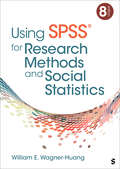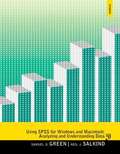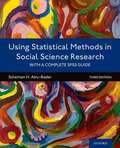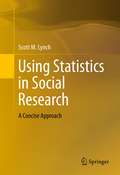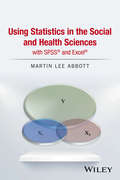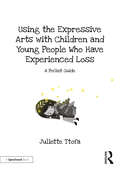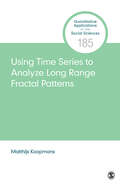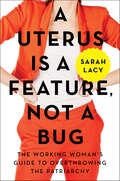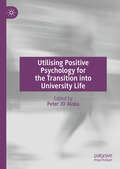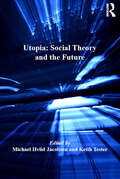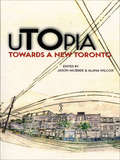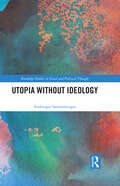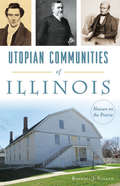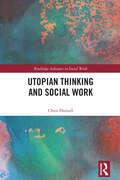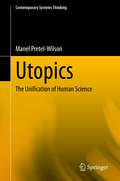- Table View
- List View
Using SPSS® for Research Methods and Social Statistics
by null William E. Wagner-HuangThis is the perfect companion for students who are learning to use the SPSS software to interpret and manage data. Students will appreciate author William E. Wagner-Huang’s step-by-step explanations of SPSS operating procedures and introductory statistical operations. The Eighth Edition uses version 29 of the software and incorporates results from the 2022 General Social Survey (GSS) as a dataset used in examples throughout the book. In response to user feedback, the author has expanded the sections on ANOVA and chi-square. The GSS datasets and codebooks for use with the text are available on an accompanying website.
Using SPSS® for Research Methods and Social Statistics
by null William E. Wagner-HuangThis is the perfect companion for students who are learning to use the SPSS software to interpret and manage data. Students will appreciate author William E. Wagner-Huang’s step-by-step explanations of SPSS operating procedures and introductory statistical operations. The Eighth Edition uses version 29 of the software and incorporates results from the 2022 General Social Survey (GSS) as a dataset used in examples throughout the book. In response to user feedback, the author has expanded the sections on ANOVA and chi-square. The GSS datasets and codebooks for use with the text are available on an accompanying website.
Using SPSS for Windows and Macintosh: Analyzing and Understanding Data
by Neil Salkind Samuel GreenThe development of easy-to-use statistical software like SPSS has changed the way statistics is being taught and learned. Even with these advancements, however, students sometimes still find statistics a tough nut to crack. Using SPSS for Windows and Macintosh, 7/e, guides students through basic SPSS techniques using step-by-step descriptions and explaining in detail how to avoid common pitfalls in the study of statistics.
Using Statistical Methods in Social Science Research: With a Complete SPSS Guide
by Soleman H. Abu-BaderUsing Statistical Methods in Social Science Research, Third Edition is the user-friendly text every student needs for analyzing and making sense of quantitative data. With over 20 years of experience teaching statistics, Soleman H. Abu-Bader provides an accessible, step-by-step description of the process needed to organize data, choose a test or statistical technique, analyze, interpret, and report research findings. <p><p>The book begins with an overview of research and statistical terms, followed by an explanation of basic descriptive statistics. It then focuses on the purpose, rationale, and assumptions made by each test, such as Pearson's correlation, student's t-tests, analysis of variances, and simple linear regression, among others. The book also provides a wealth of research examples that clearly display the applicability and function of these tests in real-world practice. In a separate appendix, the author provides a step-by-step process for calculating each test for those who still like to understand the mathematical formulas behind these processes.
Using Statistics in Social Research
by Scott M. LynchThis book covers applied statistics for the social sciences with upper-level undergraduate students in mind. The chapters are based on lecture notes from an introductory statistics course the author has taught for a number of years. The book integrates statistics into the research process, with early chapters covering basic philosophical issues underpinning the process of scientific research. These include the concepts of deductive reasoning and the falsifiability of hypotheses, the development of a research question and hypotheses, and the process of data collection and measurement. Probability theory is then covered extensively with a focus on its role in laying the foundation for statistical reasoning and inference. After illustrating the Central Limit Theorem, later chapters address the key, basic statistical methods used in social science research, including various z and t tests and confidence intervals, nonparametric chi square tests, one-way analysis of variance, correlation, simple regression, and multiple regression, with a discussion of the key issues involved in thinking about causal processes Concepts and topics are illustrated using both real and simulated data The penultimate chapter presents rules and suggestions for the successful presentation of statistics in tabular and graphic formats, and the final chapter offers suggestions for subsequent reading and study.
Using Statistics in the Social and Health Sciences with SPSS and Excel
by Martin Lee AbbottProvides a step-by-step approach to statistical procedures to analyze data and conduct research, with detailed sections in each chapter explaining SPSS® and Excel® applications This book identifies connections between statistical applications and research design using cases, examples, and discussion of specific topics from the social and health sciences. Researched and class-tested to ensure an accessible presentation, the book combines clear, step-by-step explanations for both the novice and professional alike to understand the fundamental statistical practices for organizing, analyzing, and drawing conclusions from research data in their field. The book begins with an introduction to descriptive and inferential statistics and then acquaints readers with important features of statistical applications (SPSS and Excel) that support statistical analysis and decision making. Subsequent chapters treat the procedures commonly employed when working with data across various fields of social science research. Individual chapters are devoted to specific statistical procedures, each ending with lab application exercises that pose research questions, examine the questions through their application in SPSS and Excel, and conclude with a brief research report that outlines key findings drawn from the results. Real-world examples and data from social and health sciences research are used throughout the book, allowing readers to reinforce their comprehension of the material. Using Statistics in the Social and Health Sciences with SPSS® and Excel® includes: * Use of straightforward procedures and examples that help students focus on understanding of analysis and interpretation of findings * Inclusion of a data lab section in each chapter that provides relevant, clear examples * Introduction to advanced statistical procedures in chapter sections (e.g., regression diagnostics) and separate chapters (e.g., multiple linear regression) for greater relevance to real-world research needs Emphasizing applied statistical analyses, this book can serve as the primary text in undergraduate and graduate university courses within departments of sociology, psychology, urban studies, health sciences, and public health, as well as other related departments. It will also be useful to statistics practitioners through extended sections using SPSS® and Excel® for analyzing data. Martin Lee Abbott, PhD, is Professor of Sociology at Seattle Pacific University, where he has served as Executive Director of the Washington School Research Center, an independent research and data analysis center funded by the Bill & Melinda Gates Foundation. Dr. Abbott has held positions in both academia and industry, focusing his consulting and teaching in the areas of statistical procedures, program evaluation, applied sociology, and research methods. He is the author of Understanding Educational Statistics Using Microsoft Excel® and SPSS®, The Program Evaluation Prism: Using Statistical Methods to Discover Patterns, and Understanding and Applying Research Design, also from Wiley.
Using the Expressive Arts with Children and Young People Who Have Experienced Loss: A Pocket Guide (Supporting Children and Young People Who Experience Loss)
by Juliette TtofaThis guidebook has been created to be used alongside the storybook, The Girl Who Lost the Light in Her Eyes. Using a relational approach, it explores the themes of the story and offers guidance to the adult as they use expressive arts to give the child or young person a creative outlet for their emotions. The gentle guidance offered makes this an ideal tool for non-specialists working with children experiencing loss or bereavement. It guides the adult to respond appropriately and sensitively to the grief of the child, whilst helping them journey through the grieving process. This book must be used alongside the illustrated storybook, The Girl Who Lost the Light in Her Eyes. Both books are available to purchase as a set, Supporting Children and Young People Who Experience Loss. The full set includes: • The Girl Who Lost the Light in Her Eyes, a colourfully illustrated and sensitively written storybook, designed to encourage conversation and support emotional literacy. • Using the Expressive Arts with Children and Young People Who Experience Loss, a supporting guidebook that explores a relational approach and promotes creative expression as a way through loss or bereavement. Perfectly crafted to spark communication around a difficult topic, this is an invaluable tool for practitioners, educators, parents, and anybody else looking to support a child or young person through loss or bereavement.
Using Theory to Explore Health, Medicine and Society
by Peter Kennedy Carole KennedyThis book draws on a broad range of theoretical perspectives to bring to life social theories relating to health and illness. Using case studies it provides contrasting insights into the expanding jurisdiction of medicine over popular issues, including binge drinking, obesity, the prominence of therapy and the search for happiness. The book will appeal to students and academics to show how theory can be applied to issues in health and medicine. It is also relevant reading for health professionals who may lack knowledge of social theory and how it can help to understand the relationship between health, medicine and society. The book will also benefit students in the social sciences who are familiar with social theory and interested in how it can be applied to health, medicine and society.
Using Time Series to Analyze Long-Range Fractal Patterns (Quantitative Applications in the Social Sciences #185)
by Matthijs KoopmansUsing Time Series to Analyze Long Range Fractal Patterns presents methods for describing and analyzing dependency and irregularity in long time series. Irregularity refers to cycles that are similar in appearance, but unlike seasonal patterns more familiar to social scientists, repeated over a time scale that is not fixed. Until now, the application of these methods has mainly involved analysis of dynamical systems outside of the social sciences, but this volume makes it possible for social scientists to explore and document fractal patterns in dynamical social systems. Author Matthijs Koopmans concentrates on two general approaches to irregularity in long time series: autoregressive fractionally integrated moving average models, and power spectral density analysis. He demonstrates the methods through two kinds of examples: simulations that illustrate the patterns that might be encountered and serve as a benchmark for interpreting patterns in real data; and secondly social science examples such a long range data on monthly unemployment figures, daily school attendance rates; daily numbers of births to teens, and weekly survey data on political orientation. Data and R-scripts to replicate the analyses are available on an accompanying website.
Using Time Series to Analyze Long-Range Fractal Patterns (Quantitative Applications in the Social Sciences #185)
by Matthijs KoopmansUsing Time Series to Analyze Long Range Fractal Patterns presents methods for describing and analyzing dependency and irregularity in long time series. Irregularity refers to cycles that are similar in appearance, but unlike seasonal patterns more familiar to social scientists, repeated over a time scale that is not fixed. Until now, the application of these methods has mainly involved analysis of dynamical systems outside of the social sciences, but this volume makes it possible for social scientists to explore and document fractal patterns in dynamical social systems. Author Matthijs Koopmans concentrates on two general approaches to irregularity in long time series: autoregressive fractionally integrated moving average models, and power spectral density analysis. He demonstrates the methods through two kinds of examples: simulations that illustrate the patterns that might be encountered and serve as a benchmark for interpreting patterns in real data; and secondly social science examples such a long range data on monthly unemployment figures, daily school attendance rates; daily numbers of births to teens, and weekly survey data on political orientation. Data and R-scripts to replicate the analyses are available on an accompanying website.
Using Women: Gender, Drug Policy, and Social Justice
by Nancy CampbellFrom the 1950s 'girl junkie' to the 1990s 'crack mom', Using Women investigates how the cultural representations of women drug users have defined America's drug policies in this century. In analyzing the public's continued fear, horror and outrage wrought by the specter of women using drugs, Nancy Campbell demonstrates the importance that public opinion and popular culture have played in regulating women's lives. The book will chronicle the history of women and drug use, provide a critical policy analysis of the government's drug policies and offer recommendations for the direction our current drug policies should take. Using Women includes such chapters as 'Sex, Drugs and Race in the Age of Dope'; 'Regulating Adolescents in the Postwar US'; 'Fifties Femininity'; and 'Regulating Maternal Instinct'.
A Uterus Is a Feature, Not a Bug: The Working Woman's Guide to Overthrowing the Patriarchy
by Sarah LacyA rallying cry for working mothers everywhere that demolishes the "distracted, emotional, weak" stereotype and definitively shows that these professionals are more focused, decisive, and stronger than any other force.Working mothers aren’t a liability. They are assets you—and every manager and executive—want in your company, in your investment portfolio, and in your corner. There is copious academic research showing the benefits of working mothers on families and the benefits to companies who give women longer and more flexible parental leave. There are even findings that demonstrate women with multiple children actually perform better at work than those with none or one. Yet despite this concrete proof that working mothers are a lucrative asset, they still face the "Maternal Wall"—widespread unconscious bias about their abilities, contributions, and commitment. Nearly eighty percent of women are less likely to be hired if they have children—and are half as likely to be promoted. Mothers earn an average $11,000 less in salary and are held to higher punctuality and performance standards. Forty percent of Silicon Valley women said they felt the need to speak less about their family to be taken more seriously. Many have been told that having a second child would cost them a promotion. Fortunately, this prejudice is slowly giving way to new attitudes, thanks to more women starting their own businesses, and companies like Netflix, Facebook, Apple, and Google implementing more parent-friendly policies. But the most important barrier to change isn’t about men. Women must rethink the way they see themselves after giving birth. As entrepreneur Sarah Lacy makes clear in this cogent, persuasive analysis and clarion cry, the strongest, most lucrative, and most ambitious time of a woman’s career may easily be after she sees a plus sign on a pregnancy test.
Utilising Positive Psychology for the Transition into University Life
by Peter Jo AlokaThis book uses a positive psychology approach to the assist freshmen/first year students in the transition to University life. New University are faced with varied adjustment challenges on the transition from secondary school to higher education because there are vast differences between secondary schooling and university environment including learning and teaching styles, expectation to manage themselves. Positive psychology involves reflecting on one’s weaknesses and strengths and how to capitalize on the latter and so, using case studies from South African universities, this book details how knowledge of ones strengths and weaknesses can help new University students engage in the learning process. As such, this pioneering work will be of interest to students, educators and therapy practitioners alike.
Utopia: Social Theory And The Future (Classical and Contemporary Social Theory)
by Keith TesterIn the light of globalization's failure provide the universal panacea expected by some of its more enthusiastic proponents, and the current status of neo-liberalism in Europe, a search has begun for alternative visions of the future; alternatives to the free market and to rampant capitalism. Indeed, although these alternatives may not be conceived of in terms of being a 'perfect order', there does appear to be a trend towards 'utopian thinking', as people - including scholars and intellectuals - search for inspiration and visions of better futures. If, as this search continues, it transpires that politics has little to offer, then what might social theory have to contribute to the imagination of these futures? Does social theory matter at all? What resources can it offer this project of rethinking the future? Without being tied to any single political platform, Utopia: Social Theory and the Future explores some of these questions, offering a timely and sustained attempt to make social theory relevant through explorations of its resources and possibilities for utopian imaginations. It is often claimed that utopian thought has no legitimate place whatsoever in sociological thinking, yet utopianism has remained part and parcel of social theory for centuries. As such, in addition to considering the role of social theory in the imagination of alternative futures, this volume reflects on how social theory may assist us in understanding and appreciating utopia or utopianism as a special topic of interest, a special subject matter, a special analytical focus or a special normative dimension of sociological thinking. Bringing together the latest work from a leading team of social theorists, this volume will be of interest to sociologists, social and political theorists, anthropologists and philosophers.
uTOpia: Towards a New Toronto (uTOpia)
by Alana Wilcox Jason McbrideVisions of a truly workable, liveable and world-class city are once again dancing in Torontonians' heads. In the past two years, this spirit has, directly or indirectly, manifested itself in multifarious forms: in writer Sheila Heti's sui generis lecture series, Trampoline Hall; in the transformation of derelict hotels such as the Drake and the Gladstone into cultural hotspots; in renewed interest in waterfront revitalization and public transportation; in exciting, controversial architectural developments such as the OCAD building, the expansion of the ROM and the AGO; in the [murmur] project, which catalogues stories about Toronto neighbourhoods and broadcasts them to people's cell phones; in the explosion of the local independent music scene.uTOpia aims to capture and chronicle that spirit, collecting writing by many of the people inspired by and involved in these projects. Featuring passionate, visionary essays by thirty-four different journalists, artists, thinkers, architects and activists, uTOpia is a compendium of ideas, opinions and strategies. The anthology explores plans to redevelop the Island airport into a Ward's Island-style community; how the Zeidler family is energizing artist-run centres; what a car-free Kensington Market might mean; the necessity and beauty of laneway housing; the way past efforts to combat devastating developments like the Spadina Expressway have shaped current activism; what a utopian Toronto might look like mapped out; and much, much more. Playful, erudite and accessible, uTOpia writes Toronto as it is shared and created by the people who live here. Though it is by no means a complete picture of what is happening in the city right now, it will hopefully show that what was once just a T-shirt slogan - I Heart T.O. - is now genuine, heartfelt sentiment.Contributors include Howard Akler, Andrew Alfred-Duggan, Jacob Allderdice, Bert Archer, James Bow, Nicole Cohen, Jonny Dovercourt, Dale Duncan, Philip Evans, Mark Fram, Misha Glouberman, Chris Hardwicke, Sheila Heti, Alfred Holden, Luis Jacob, Lorraine Johnson, Edward Keenan, Mark Kingwell, John Lorinc, Sally McKay, Heather McLean, Dave Meslin, Shawn Micallef, Derek Murr, Ninjalicious, Darren O'Donnell, Planning Action, Barbara Rahder, Dylan Reid, Erik Rutherford, Jeffrey Stinson, Deanne Taylor, Conan Tobias, Stéphanie Verge, Adam Vaughan and Marlena Zuber.
Utopia/Dystopia: Conditions of Historical Possibility
by Michael D. Gordin, Helen Tilley and Gyan PrakashThe concepts of utopia and dystopia have received much historical attention. Utopias have traditionally signified the ideal future: large-scale social, political, ethical, and religious spaces that have yet to be realized. Utopia/Dystopia offers a fresh approach to these ideas. Rather than locate utopias in grandiose programs of future totality, the book treats these concepts as historically grounded categories and examines how individuals and groups throughout time have interpreted utopian visions in their daily present, with an eye toward the future. From colonial and postcolonial Africa to pre-Marxist and Stalinist Eastern Europe, from the social life of fossil fuels to dreams of nuclear power, and from everyday politics in contemporary India to imagined architectures of postwar Britain, this interdisciplinary collection provides new understandings of the utopian/dystopian experience. The essays look at such issues as imaginary utopian perspectives leading to the 1856-57 Xhosa Cattle Killing in South Africa, the functioning racist utopia behind the Rhodesian independence movement, the utopia of the peaceful atom and its global dissemination in the mid-1950s, the possibilities for an everyday utopia in modern cities, and how the Stalinist purges of the 1930s served as an extension of the utopian/dystopian relationship. The contributors are Dipesh Chakrabarty, Igal Halfin, Fredric Jameson, John Krige, Timothy Mitchell, Aditya Nigam, David Pinder, Marci Shore, Jennifer Wenzel, and Luise White.
Utopia, Equity and Ideology in Urban Texts: Fair and Unfair Cities (Literary Urban Studies)
by Michael G. Kelly Mariano PazUtopia, Equity and Ideology in Urban Texts: Fair and Unfair Cities explores the complex interrelations of three key critical topics across a diverse range of urban writing. Interrogating the links and tensions between aesthetic and political priorities in the representation and imagining of urban life, the volume engages with work from a wide variety of linguistic and cultural origins and across a range of textual practices having the urban phenomenon as a common framing concern. Individual contributions discussing genre and literary fiction, poetic writing, documentary and essayistic texts, planning manifestos and municipal communications materials serve to demonstrate that the nuanced treatments of urban experience and potential which may be gleaned from across this textual spectrum act as a pragmatic corrective to purely conceptual approaches. As such, the volume consolidates the emerging dialogue between the fields of utopian studies and literary urban studies, understanding these as complementary approaches to the reading of the city and its textual prolongations.
Utopia without Ideology (Routledge Studies in Social and Political Thought)
by Ambrogio SantambrogioThis book explores and proposes original definitions of central terms in political sociology and social theory, including political culture, imaginary, ideology, and utopia, in a manner that renders the individual definitions consistent with one another as part of a single and general conceptual framework for understanding social action. Through a Weberian distinction between means, ends, and values, together with the thought of Alfred Schütz and phenomenological sociology more generally, it sheds light on the ways in which the book’s key concepts make sense of social action, advancing the view that, rather than some promised land or aspiration, utopia is a project of broad and far-reaching collective action realized in its own enactment. As such, the book will appeal to scholars of social theory, political sociology, and political theory.
Utopian Communities of Illinois: Heaven on the Prairie
by Randall J. SolandThe Prairie State became a crucial testing ground for the grand American thought experiment on how a society should be constructed. Between 1839 and 1901, six different utopian communities chose Illinois as the laboratory and sanctuary to elevate their ideals into reality. The Mormons and the Icarians selected Nauvoo. The Janssonists picked Bishop Hill. The Fourierists settled on the north edge of Loami. The employees of the Pullman Railroad Car Company naturally resided in Pullman, and the Dowietes put down roots in Zion. Three were religious and the others secular. All possessed charismatic leaders and dramatic stories that drew attention from across the globe. Randy Soland examines the relationship between these havens and their legacies.
The Utopian Constellation: Future-Oriented Social and Political Thought Today
by Chamsy el-OjeiliThis book examines the utopian dimension of contemporary social and political thought. Arguing for a utopian optic for the human sciences, el-Ojeili claims that major transformations of the utopian constellation have occurred since the end of the twentieth century. Following a survey of major utopian shifts in the modern period, el-Ojeili focuses on three spaces within today’s utopian constellation. At the liberal centre, we see a splintering effect, particularly after the global financial crisis of 2008: a contingent neo-liberalism, a neo-Keynesian turn, and a liberalism of fear. At the far-Right margin, we see the consolidation of post-fascism, a combination of “the future in the past”, elements of the post-modern present, and appeals to a novel future. Finally, at the far-Left, a new communism has emerged, with novel positions on resistance, maps of power, and a contemporary variant of the Left’s artistic critique. The Utopian Constellation will be of interest to scholars and students across the human sciences with an interest in utopian studies, ideological and discourse analysis, the sociology of knowledge, and the study of political culture.
Utopian Thinking and Social Work (Routledge Advances in Social Work)
by null Chris HorsellThis book highlights the importance of employing imaginative sensibilities to thinking and action in social work and social policy practice. Exploring the question of how ideas about utopia and utopian method can be used in social work practice and policy practice to address social inequalities, it shows that central to this critique is the argument that contemporary social policy responses and subsequent social work interventions to a range of policy problems (e.g. homelessness, poverty, family violence) need to acknowledge the failure of dominant neoliberal discourses in addressing these issues. The COVID-19 pandemic has highlighted and, in many ways, exacerbated existing inequalities, and the post-pandemic future provides opportunities to put utopian ideas into action. Showing how utopian thinking can challenge fundamental assumptions regarding welfare dependency and unitary identities in policy settings, this book will be of interest to all scholars, students and professionals working in social work and social policy.
The Utopian Vision Of Charles Fourier; Selected Texts On Work, Love, And Passionate Attraction
by Charles FourierThe Utopian Vision Of Charles Fourier; Selected Texts On Work, Love, And Passionate Attraction by Charles Fourier
Utopics: The Unification of Human Science (Contemporary Systems Thinking)
by Manel Pretel-WilsonThe book consolidates systems thinking as a new world-hypothesis that is already suggesting itself behind the advancement of quantum mechanics and Ashby’s cybernetics. In particular, it shows how Einstein’s misgivings about quantum mechanics boil down to his persistence in defending the principle of contiguity at the root of the modern cosmology and, in relation to neo-cybernetics, the book rediscovers Ashby’s theory of adaptive behaviour enabling a new synthesis between physiology, psychology and ethology that has implications for systems practice. Furthermore, this new “cosmology” comes with a new “anthropology” that informs utopics, the science of utopic systems, and sheds new light on the actual founding fathers of the domain of human science. In particular, the book provides an understanding of how our human world works and how it is being constituted by utopic systems that look into the future to realize something possible. Finally, it points the way to the future unification of knowledge bringing together systems philosophy and systems science given that world-hypothesis is what makes logically possible the development and consolidation of all the different domains of science.
